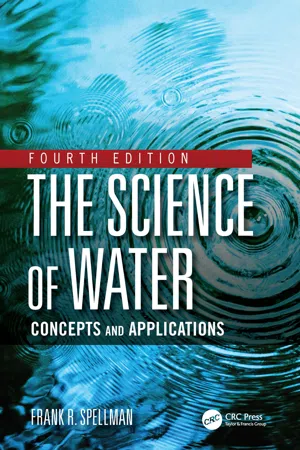
- 612 pages
- English
- ePUB (mobile friendly)
- Available on iOS & Android
About This Book
The Science of Water: Concepts and Applications, Fourth Edition, contains a wealth of scientific information and is based on real-world experience. Building on the third edition, this text applies the latest data and research in the field and addresses water contamination as a growing problem. The book material covers a wide range of water contaminants and the cause of these contaminants and considers their impact on surface water and groundwater sources. It also explores sustainability and the effects of human use, misuse, and reuse of freshwater and wastewater on the overall water supply.
Provides Valuable Insight for Water/Wastewater Practitioners
Designed to fill a gap in the available material about water, the book examines water reserve utilization and the role of policymakers involved in the decision-making process. The book provides practical knowledge that practitioners and operators must have in order to pass licensure/certification tests and keep up with relevant changes. It also updates all previous chapters, presents numerous example math problems, and provides information not covered in earlier editions.
Features:
-
- Is updated throughout and adds new problems, tables, and figures
-
- Includes new coverage on persistent chemicals in drinking water and the latest techniques in converting treated wastewater to safe drinking water
-
- Provides updated information on pertinent regulations dealing with important aspects of water supply and treatment
The Science of Water: Concepts and Applications, Fourth Edition, serves a varied audience—it can be utilized by water/wastewater practitioners, as well as students, lay personnel, regulators, technical experts, attorneys, business leaders, and concerned citizens.
Frequently asked questions
Information
1 Introduction
It quenches the thirst of 40 million people and wets and nourishes more than 5 million acres of farmland from Wyoming to Southern California. Well, the fact is it does all this at the present time; the present time being summer of 2019.The future?To cut a long story short and get to the point in plain English, you understand, let’s just say that climate change is having a sapping impact on it; thus, its future is not exactly clear—predictable but somewhat cloudy and more exactly to the point, very dry.The problem with climate change?Well, it is all about receding snowpack due to higher temperatures. The fact is that because its essence is water (with a bit of sand, rock and human-made chemicals and trash thrown in), it is subject to evaporation (along with overuse too, of course, that makes its essence in a declining mode).In a recent backpacking journey in Utah to its confluence with the Green River, it was quite apparent to me that the Colorado River was/is dying; its flow has substantially decreased and continues to decrease at an alarming rate.Am I crying wolf?More to the point, I am thinking about thirst, dryness, dehydration, and the future need for liquid.—Frank R. Spellman (2019)
When color photographs of the earth as it appears from space were first published, it was a revelation: they showed our planet to be astonishingly beautiful. We were taken by surprise. What makes the earth so beautiful is its abundant water. The great expanses of vivid Blue Ocean with swirling, sunlit clouds above them should not have caused surprise, but the reality exceeded everybody’s expectations. The pictures must have brought home to all who saw them the importance of water to our planet.—E. C. Pielou, Preface, 1998
Fresh water is unique from other commodities in that it has no substitutes.—Sandra Postel et al., 1996
- Leonardo da Vinci gave us insight into more of water’s apparent contradictions:
- Water is sometimes sharp and sometimes strong, sometimes acid and sometimes bitter;
- Water is sometimes sweet and sometimes thick or thin;
- Water sometimes brings hurt or pestilence, sometimes health-giving, sometimes poisonous.
- Water suffers changes into as many natures as are the different places through which it passes.
- Water, as with the mirror that changes with the color of its object, so it alters with the nature of the place, becoming: noisome, laxative, astringent, sulfurous, salt, incarnadined, mournful, raging, angry, red, yellow, green, black, blue, greasy, fat or slim.
- Water sometimes starts a conflagration, sometimes it extinguishes one.
- Water is warm and is cold.
- Water carries away or sets down.
- Water hollows out or builds up.
- Water tears down or establishes.
- Water empties or fills.
- Water raises itself or burrows down.
- Water spreads or is still.
- Water is the cause at times of life or death, or increase of privation, nourishes at times and at others does the contrary.
- Water, at times has a tang, at times it is without savor.
- Water sometimes submerges the valleys with great flood.
- In time and with water, everything changes.
Still Water
Table of contents
- Cover
- Half-Title
- Title
- Copyright
- Dedication
- Contents
- Preface
- Author Bio
- Chapter 1 Introduction
- Chapter 2 All about Water
- Chapter 3 Water Hydraulics
- Chapter 4 Water Chemistry
- Chapter 5 Water Biology
- Chapter 6 Water Ecology
- Chapter 7 Water Pollution
- Chapter 8 Environmental Biomonitoring, Sampling, and Testing
- Chapter 9 Water Economics
- Chapter 10 Water Use and Availability
- Chapter 11 Water Treatment
- Chapter 12 Water Treatment Calculations
- Appendix: Chapter 11 Answers for Quiz
- Glossary
- Index